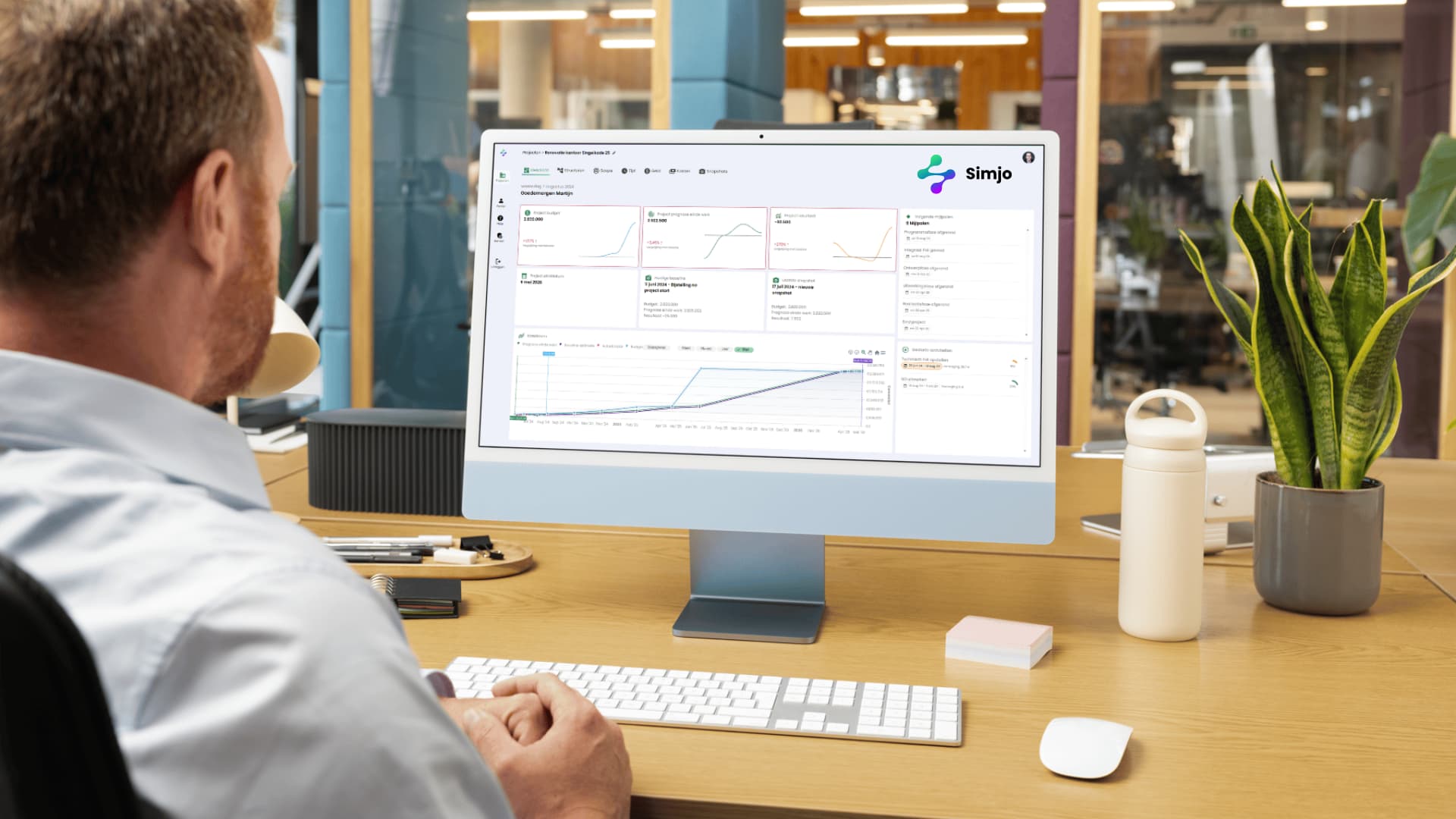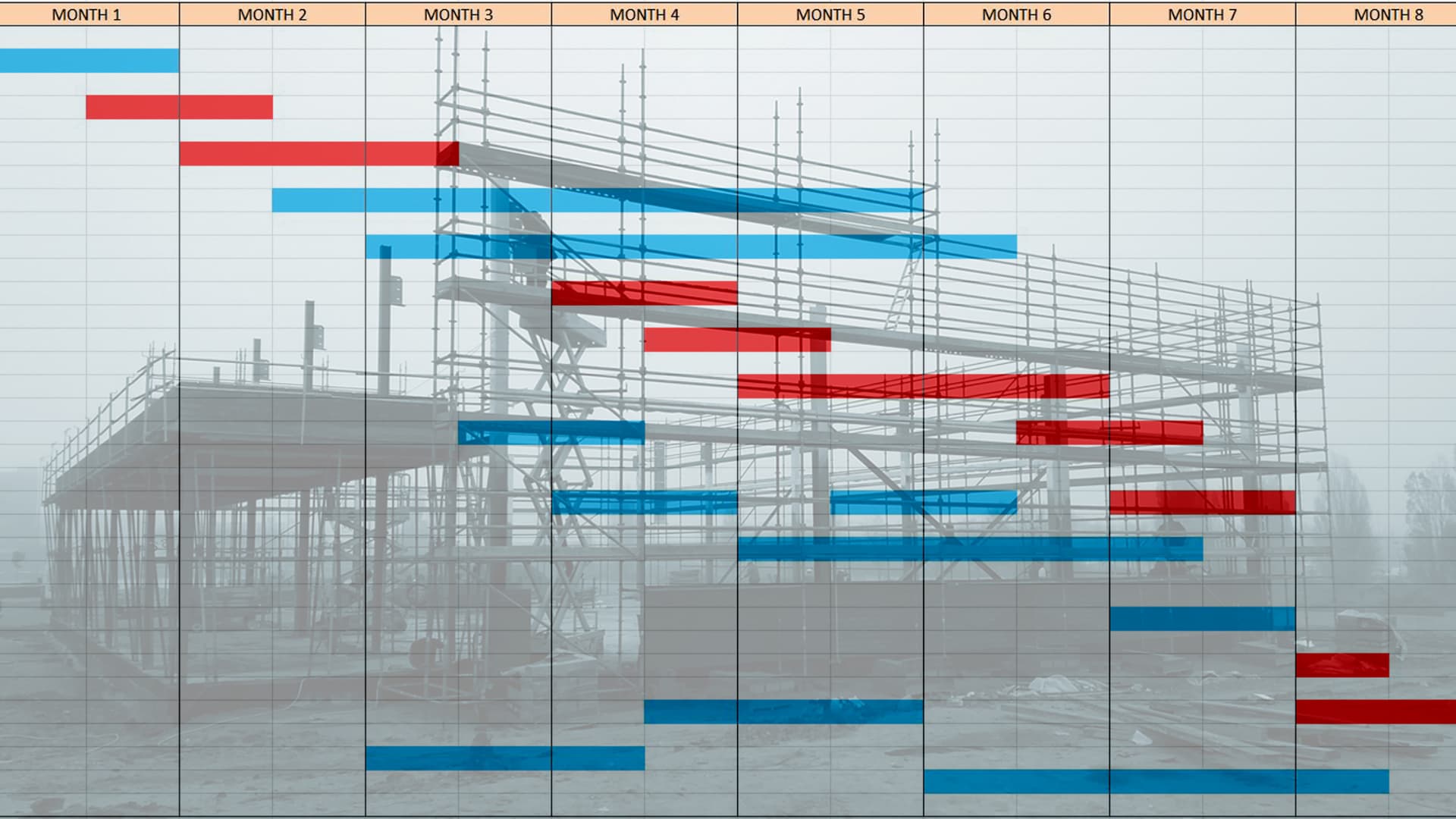Blogs
Comparing project management software: Simjo vs Excel
Project management software is an indispensable tool for construction companies today. It offers numerous benefits, such as streamlining the construction process, increasing productivity and improving communication within teams. But what are the essential parts of project management software? In this article we discuss those components and compare them with Excel and Simjo.
1. Dashboard for Comprehensive Overview
A dashboard function provides a clear display of all crucial steering information for your construction project in one place. It offers insights into deadlines, milestones, budgets, and recent activities within the project. Utilizing a dashboard enables you to promptly address issues or delays, ensuring agile responses. Furthermore, it facilitates task tracking for team members and provides a snapshot of tasks with prioritized importance.
2. Interactive Planning for Swift Plan Adjustments
The planning process is often intricate and time-consuming. An interactive planning feature allows for rapid adjustments to plans without compromising their accuracy. It empowers all users of the project management software to explore and compare various scenarios using real-time data.
3. Milestone Overview
A milestone overview offers clarity on the goals your construction project team must achieve within a specific timeframe. This aids in prioritization and setting realistic deadlines. Additionally, it offers a snapshot of your project’s progress and highlights milestones already accomplished, contributing to better expectation management for all stakeholders.
4. Invoice and Commitments Overview
An invoice overview is invaluable for construction teams operating within fixed budgets and billable hours. It provides visibility into hours allocated to the project and the remaining budget. This insight aids in making informed decisions later in the process.
5. Cash Flow Chart
A cash flow chart visually represents the financial status of a project, showcasing both incoming and outgoing funds. This quick insight highlights budget overruns or shortfalls, aiding investment decisions and cost control.
Also read: Budget overruns in construction projects: point for attention and tips
6. Baseline Management
A baseline serves as a reference point for what you aim to achieve during the construction project. Baseline management enables users to track changes relative to these benchmarks. This way, deviations and their causes are readily identifiable, aiding in problem-solving within the project.
Also read: In five steps to better risk management of the contruction project
7. Reporting Capabilities
Effective reporting capabilities are pivotal for successful construction project management, as they provide crucial information to all stakeholders. This information empowers decision-making based on factual data. Adaptability of reporting options to an organization’s specific needs is essential, ensuring users receive relevant information.
8. Integrated Project Data
Centralizing project data is one of the core functions of project management software. Users should be able to capture and manage all pertinent project information, including project objectives, timelines, budgets, tasks, and resources.
Comprehensive display of project data simplifies informed decision-making, progress monitoring, and efficient communication throughout the project.
Also read: The benefits of a master planning for your construction project
9. Uniformity
Effective project management software should offer uniformity through standardized templates and workflows. This enables consistent project planning and execution across the organization, minimizing confusion and reducing the likelihood of errors. Standardized documentation also facilitates knowledge transfer and enables enhanced analysis and reporting.
10. Task Suggestions
The ability to suggest and automate tasks is a valuable feature in project management software. Intelligent algorithms can analyze project requirements, dependencies, and historical data to recommend tasks and their sequences.
Task suggestions aid project managers and team members in prioritization and effective work planning. This not only saves time but also ensures project teams stay on track. Additionally, it simplifies logical and efficient task completion.
11. Focus
Perhaps the most crucial component of successful project management software is focus. The software should offer a clear and intuitive interface, allowing users to concentrate on their core activities without distractions.
Clear dashboards, customizable views, and smart filtering options contribute to higher productivity and better decision-making. Additionally, features like milestone tracking, progress visualization, and timely notifications help maintain focus on project goals and deadlines.
Using Excel for Construction Project Management
Construction projects are complex and demanding undertakings that require significant attention from project managers. Having the right tools is crucial to ensure projects are completed on time and within budget. One of the most commonly used tools in the construction sector is Microsoft Excel. But why do project managers opt for Excel, and what are its drawbacks?
There are several reasons why project managers use Excel in construction project management:
- Excel is a familiar program for many, making it easy to understand and use without requiring additional training.
- Moreover, Excel is a cost-effective option compared to other software programs for construction project management. This accessibility is particularly beneficial for smaller companies or organizations with limited resources.
However, Excel does come with limitations when used as a project management tool:
- Excel does not offer all the features required for complex construction projects. Managing multiple project plans simultaneously or performing risk and cost analyses, for instance, can be challenging.
- Excel spreadsheets are prone to errors due to human data entry or formula mistakes. This can lead to inaccurate decisions and ultimately higher costs.
- Finally, Excel spreadsheets are relatively vulnerable to hacking or unauthorized access. This can result in the loss or theft of critical project information.
Also read: Why Excel is not an appropriate tool for construction project management
Simjo Project Management Software: Tailored for Construction
Out of frustration with the lack of clear and simple tools for comprehensive steering of time, scope, and budget adjustments, Simjo emerged in 2023. Specifically designed for use in construction projects, Simjo simplifies delivering projects on time, within scope and budget, while enhancing communication. All of this is achieved while maintaining the user-friendliness of Excel.
Refer to the table below to see the advantages Simjo offers over Excel in the realm of construction project management.

Conclusion
Project management software presents numerous advantages for construction companies aiming for effective and efficient project management. Key components of top-notch project management software encompass dashboard functions, interactive planning, milestone overviews, invoice insights, cash flow charts, baseline management, and reporting capabilities.
By leveraging these components, you can better manage your construction project, identify problematic areas before they escalate, and ensure your team achieves goals within set deadlines and budgets. Improved communication between team members and stakeholders is an added bonus.
Also read: How do you choose the right project management software for your construction project?
Interested in discovering how Simjo supports your construction project?
Simjo is project management software specifically developed for project managers and teams in construction. Learn how Simjo simplifies your work here. Or sign up for Simjo. We’ll keep you updated on Simjo’s development, and you’ll be among the first to experience new features.









